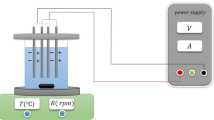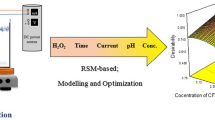Abstract
The electrochemical oxidation (ECO) of carbamazepine (CBZ), an antiepileptic drug, has been carried out in this study. A response surface methodology approach (RSM) was used in order to optimize the treatment process for CBZ removal on synthetic effluent. Four different operating parameters (current intensity, treatment time, recycling flow rate, and anode type) were chosen as key factors while a single response (CBZ removal) was considered. In the first part of the study, a factorial design (FD) methodology was carried out in order to evaluate the effects and interactions between the selected factors. Results showed that anode type is the most important parameters affecting CBZ degradation (with 67% of the overall effect) followed by the treatment time, the current intensity, and then the recirculation flow rate. Subsequently, a central composite design (CCD) was conducted in order to optimize the overall process taking into account efficiency (CBZ removal) and energy consumption. The contribution of direct and indirect effects of CBZ electro-oxidation was also investigated. As expected, direct oxidation was the most dominant mechanism during ECO with approximately 66% whereas indirect oxidation contributed with only 12%. Finally, the determined optimal conditions were applied on real pharmaceutical wastewater. Despite the effect matrix, 84% of CBZ was obtained after only 100 min of treatment with 23% of mineralization. Finally, CBZ by-products such as salicylic acid, catechol, and anthranilic have been detected during the oxidation process.





Similar content being viewed by others
Abbreviations
- ANOVA:
-
Analysis of variance
- CBZ:
-
Carbamazepine
- CCD:
-
Central composite design
- CF:
-
Carbon felt
- ECO:
-
Electrochemical oxidation
- FD:
-
Factorial design
- GC-MS:
-
Gas chromatography coupled with mass spectrometry
- Gr:
-
Graphite
- LC/MS-MS:
-
Liquid chromatography-tandem mass spectrometry
- PVC:
-
Polyvinyl chloride
- RSM:
-
Response surface methodology
- Ti/PbO2 :
-
Titanium coated with lead oxide
- Ti/Pt:
-
Titanium coated with platinum
- TOC:
-
Total organic carbon
References
Anglada, A., Urtiaga, A., & Ortiz, I. (2009). Contributions of electrochemical oxidation to waste-water treatment: fundamentals and review of applications. Journal of Chemical Technology and Biotechnology, 84, 1747–1755.
Cheng, W., Singh, N., Maciá-Agulló, J. A., Stucky, G. D., McFarland, E. W., & Baltrusaitis, J. (2012). Optimal experimental conditions for hydrogen production using low voltage electrooxidation of organic wastewater feedstock. International Journal of Hydrogen Energy, 37, 13304–13313.
Daghrir, R., Drogui, P., & Robert, D. (2012). Photoelectrocatalytic technologies for environmental applications. Journal Photochemistry and Photobiology A, 238, 41–52.
Daghrir, R., Drogui, P., & Tshibangu, J. (2014a). Efficient treatment of domestic wastewater by electrochemical oxidation process using bored doped diamond anode. Separation and Purification Technology, 131, 79–83.
Daghrir, R., Drogui, P., Tshibangu, J., Delegan, N., & El Khakani, M. A. (2014b). Electrochemical treatment of domestic wastewater using boron-doped diamond and nanostructured amorphous carbon electrodes. Environemental Science and Pollution Research, 21, 6578–6589.
Dai, C. M., Zhou, X. F., Zhang, Y. L., Duan, Y. P., Qiang, Z. M., & Zhang, T. C. (2012). Comparative study of the degradation of carbamazepine in water by advanced oxidation processes. Environmental Technology, 33, 1101–1109.
Domínguez, J. N. R., González, T., Palo, P., & Sánchez-Martín, J. (2010). Electrochemical advanced oxidation of carbamazepine on boron-doped diamond anodes. Influence of operating variables. Industrial & Engineering Chemistry Research, 49, 8353–8359.
Engel, J., Pedley, T.A., Aicardi, J., 2007. Epilepsy: a comprehensive textbook. Lippincott Williams & Wilkins.
Guo, T. J., Englehardt, J., & Wu, T. T. (2014). Review of cost versus scale: water and wastewater treatment and reuse processes. Water Science and Technology, 69, 223–234.
Houeto, P., Carton, A., Guerbet, M., Mauclaire, A.-C., Gatignol, C., Lechat, P., & Masset, D. (2012). Assessment of the health risks related to the presence of drug residues in water for human consumption: application to carbamazepine. Regulatory Toxicology and Pharmacology, 62, 41–48.
Im, J.-K., Cho, I.-H., Kim, S.-K., & Zoh, K.-D. (2012a). Optimization of carbamazepine removal in O 3/UV/H 2 O 2 system using a response surface methodology with central composite design. Desalination, 285, 306–314.
Im, J. K., Son, H. S., Kang, Y. M., & Zoh, K. D. (2012b). Carbamazepine degradation by photolysis and titanium dioxide photocatalysis. Water Environment Research, 84, 554–561.
Jelić, A., Gros, M., Petrović, M., Ginebreda, A., Barceló, D., 2012. Occurrence and elimination of pharmaceuticals during conventional wastewater treatment. Emerging and priority pollutants in rivers. Springer, pp. 1–23.
Jelic, A., Michael, I., Achilleos, A., Hapeshi, E., Lambropoulou, D., Perez, S., Petrovic, M., Fatta-Kassinos, D., & Barcelo, D. (2013). Transformation products and reaction pathways of carbamazepine during photocatalytic and sonophotocatalytic treatment. Journal of Hazardous Materials, 263, 177–186.
Jeong, J., Kim, C., & Yoon, J. (2009). The effect of electrode material on the generation of oxidants and microbial inactivation in the electrochemical disinfection processes. Water Research, 43, 895–901.
Kosjek, T., Andersen, H. R., Kompare, B., Ledin, A., & Heath, E. (2009). Fate of carbamazepine during water treatment. Environmental Science & Technology, 43, 6256–6261.
McDowell, D. C., Huber, M. M., Wagner, M., Von Gunten, U., & Ternes, T. A. (2005). Ozonation of carbamazepine in drinking water: identification and kinetic study of major oxidation products. Environmental Science & Technology, 39, 8014–8022.
Miao, X.-S., & Metcalfe, C. D. (2003). Determination of carbamazepine and its metabolites in aqueous samples using liquid chromatography-electrospray tandem mass spectrometry. Analytical Chemistry, 75, 3731–3738.
Monteagudo, J., Durán, A., González, R., & Expósito, A. (2015). In situ chemical oxidation of carbamazepine solutions using persulfate simultaneously activated by heat energy, UV light, Fe 2+ ions, and H 2 O 2. Applied Catalysis B: Environmental, 176, 120–129.
Muhamad, M. H., Abdullah, S. R. S., Mohamad, A. B., Rahman, R. A., & Kadhum, A. A. H. (2013). Application of response surface methodology (RSM) for optimisation of COD, NH 3–N and 2, 4-DCP removal from recycled paper wastewater in a pilot-scale granular activated carbon sequencing batch biofilm reactor (GAC-SBBR). Journal of Environmental Management, 121, 179–190.
Pimentel, M., Oturan, N., Dezotti, M., & Oturan, M. A. (2008). Phenol degradation by advanced electrochemical oxidation process electro-Fenton using a carbon felt cathode. Applied Catalysis B: Environmental, 83, 140–149.
Sigler, P. B., & Masters, B. (1957). The hydrogen peroxide-induced Ce*(III)-Ce (IV) exchange System1. Journal of the American Chemical Society, 79, 6353–6357.
Stoykova, M., Koumanova, B., & Mörl, L. (2013). Adsorptive removal of carbamazepine from wastewaters by activated charcoals. Journal of Chemical Technology and Metallurgy, 48, 469–474.
Vogna, D., Marotta, R., Andreozzi, R., Napolitano, A., & d’Ischia, M. (2004). Kinetic and chemical assessment of the UV/H 2 O 2 treatment of antiepileptic drug carbamazepine. Chemosphere, 54, 497–505.
Yoshimura, R., Yanagihara, N., Terao, T., Minami, K., Toyohira, Y., Ueno, S., Uezono, Y., Abe, K., & Izumi, F. (1998). An active metabolite of carbamazepine, carbamazepine-10, 11-epoxide, inhibits ion channel-mediated catecholamine secretion in cultured bovine adrenal medullary cells. Psychopharmacology, 135, 368–373.
Author information
Authors and Affiliations
Corresponding author
Rights and permissions
About this article
Cite this article
Guitaya, L., Azaïs, A., Zaviska, F. et al. Electrochemical Oxidation as Treatment for Contaminated Wastewaters by Carbamazepine: Process Optimization Through Response Surface Methodology. Water Air Soil Pollut 228, 384 (2017). https://doi.org/10.1007/s11270-017-3565-4
Received:
Accepted:
Published:
DOI: https://doi.org/10.1007/s11270-017-3565-4




